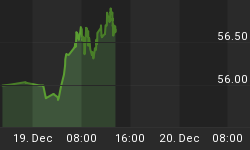Timing attempts to provide market equivalent returns over the long term, with a substantial reduction in variability of returns. The two components of the Timing program are EZ+Macro and Fear/Greed. This system trades rarely and splits its allocations between ETFs tracking the S&P 500, the intermediate-term U.S. Treasuries, and cash.
System recap is presented first this week, followed by extended commentary and charts.
System Summary
Information is as of the close on June 13, 2008.
EZ+Macro

EZ Trend is still down. The divergence had been reversing as of the last update, but since then the difference between the averages has stabilized.

Macro Trend is still bullish for Treasuries. This comes into play only if the EZ Trend is not up. Note that this trend is certainly reversing at present.
Fear/Greed

The Fear/Greed model signaled a buy for the U.S. stock market in early November, and a sell in December, as the $VIX relative to actual volatility fell to a historically low level. For most of the last six months, the current level of sentiment, as measured by the $VIX relative to actual volatility, has been at levels historically associated with complacency. It has only been in the last month that the measurement is anywhere close to historical "norms." In the scale of the chart, 80% of the readings since 1990 have been between the red and green lines.
Model Allocation
Based on beginning with a $100,000 portfolio at inception. The portfolio weights are shown behind the ticker symbol, and are rounded to the tenth of a percent.
S&P 500 SPDRs (SPY) 23.9% weight
iShares 7-10 Year Treasury Bond Fund (IEF) 25.5% weight
Cash 50.6% weight
Returns
Based on beginning with a $100,000 portfolio at inception.
Equity: $98,093.83
Gain, Last 4 weeks: -1.88%
Gain, Year to Date: -4.18%
Gain, Since Inception on 11/12/2007: -2.91%
These returns include the recent May distribution from IEF of $0.28 per share. This system has been approximately 50% allocated to cash since December 21, 2007, and I have not been including gains from cash interest in the returns.
Changes To Model Allocation
There are no changes to the model allocation since this previous message. It is listed below:
S&P 500 SPDRs (SPY) 25.0% weight
iShares 7-10 Year Treasury Bond Fund (IEF) 25.0% weight
Cash 50.0% weight
Tracking
There are no changes to track.
Commentary
My overall thesis, that the U.S. stock market has set up for an intermediate-to-long-term bottom, as discussed much earlier, has not changed. Keep in mind that the Timing system is mechanical, and will be tracked based on the signals it generates. The system went 50/50 stocks/cash on December 21, 2007, and then on January 18, 2008 went to 25/25/50 stocks/bonds/cash.
Reviewing last month's summary opinion:
The best risk/return, although highest volatility, entry opportunities have passed; those were at the bottom in January and the retest in March. Today does not present as good an opportunity, because of some short- and medium-term "overbought" conditions. I suspect that the broad movement off of the retest in March will segregate itself by sector, with leadership emerging and some lagging sectors falling below their 50 day moving averages, and the index working off its "overboughtness."
The short-term overbought condition resolved itself pretty quickly, with an immediate move down the next week. The medium-term overbought condition took longer to resolve, basically the full four weeks since the last review, and moved down further than I had thought probable, below the levels marked as possible support in the chart below. If the chart is truncated in your browser, click on it to view it in full size.

Despite the movement below possible support, the weekly chart has some signs of encouragement. Check out the hammer pattern, on high volume, which printed last week. If it holds, it will be a significantly higher low than in March or January, and many technical analysts will see that as confirmation of an uptrend.

This hammer pattern, which is really just a rejection of the lows following a downtrend, is repeated in several places, including many breadth measurements. Here is the hammer pattern executed on a chart of S&P 500 stocks trading above their 50-day moving averages; note my comment at the last update was that "the percentage of S&P 500 stocks trading above their 50 day moving averages is fairly high." Keep in mind that there's a HUGE difference between a good signal for initiating short positions, and a good signal of poor risk/reward for initiating long positions, and I see this breadth measurement being high as a sign of the latter, not the former.

Here's the hammer pattern shown on a chart of S&P 500 stocks trading above their 200-day moving averages.

Summary
The bottom and retest, in January and March, were the best buying opportunities, although they would have been stomach-turning in volatility. The current situation, a pullback from an overbought position, followed by multiple hammers in weekly charts, represents a pretty strong opportunity for deploying capital into the market.
In regards to the Timing model portfolio, it will continue to follow its mechanical signals. If the price action proceeds as I anticipate, it will switch to a higher long percentage in the next few weeks, and will only move into its highest exposure if there is a significant spike in fear, which might actually be possible in the near future, given the vanishing of complacency which took place last month.
If you'd like to become of member of The Rempel Report, you can register here. At The Rempel Report, I track model portfolios for four different mechanical trading systems, as well as my personal portfolio, and disclose all results (good and bad) at regular intervals. Members receive email notification of new posts and can contribute to the site through comments. Registration is still free!















